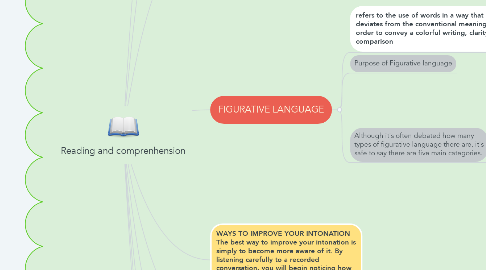
1. Critical Thinking is an extension of Critical Reading: Thinking critically, in the academic sense, involves being open-minded - using judgement and discipline to process what you are learning about without letting your personal bias or opinion detract from the arguments
2. WORD STRESS: In English, some syllables have stress, that is, they can be longer, louder, and at a higher pitch compared to unstressed syllables.
3. Critical Reading Strategies:
3.1. Annotating
3.2. Contextualizing.
3.3. Paraphrasing.
3.4. Summarizing.
3.5. Exploring the figurative language
3.6. Evaluating the logic of an argument
3.7. Recognizing emotional manipulation
4. WAYS TO IMPROVE YOUR INTONATION The best way to improve your intonation is simply to become more aware of it. By listening carefully to a recorded conversation, you will begin noticing how other speakers use intonation to express themselves
5. TEXT TYPES AND GENRES
5.1. An expository text is intended to identify and characterize experiences, facts, situations, and actions. It is meant to explain, inform or describe and they are the most frequently used structures.
5.1.1. NARRATIVE TEXT
5.1.2. ARGUMENTATIVE TEXT
5.2. GENRES
5.2.1. By being exposed to different types of genres, students develop the skills needed to determine and analyze the main characteristics of complex texts.
5.2.1.1. MAIN GENRES
5.2.1.1.1. Fiction
5.2.1.1.2. Non fiction
5.2.1.1.3. Drama
5.2.1.1.4. Poetry
5.2.1.1.5. Folklore
6. Reading Skills Meaning from Context
6.1. Guessing meaning from context: Guessing from context refers to the ability to infer the meaning of an expression using contextual clues. These clues may be purely linguistic or situational: -Linguistic context, -Situational context
6.1.1. Factors affecting our guessing ability
6.1.1.1. Reader related variables
6.1.1.2. Text-related variables
6.1.2. Techniques for guessing
6.1.2.1. Synonyms and definitions
6.1.2.2. Antonym and contrast
6.1.2.3. Cause and effect
6.1.2.4. Word forms
6.1.2.5. General knowledge
7. FIGURATIVE LANGUAGE
7.1. refers to the use of words in a way that deviates from the conventional meaning in order to convey a colorful writing, clarity, or comparison
7.1.1. We use figurative language to describe an object, person, or situation by comparing it to something else.
7.2. Purpose of Figurative language
7.3. Although it's often debated how many types of figurative language there are, it's safe to say there are five main categories.
7.3.1. Hyperbole
7.3.2. Metaphor
7.3.3. Personification
7.3.4. Simile
7.3.5. Idiom
7.3.6. Symbolism
8. INTONATION
8.1. Intonation has been characterized as “the rising and falling of the voice to various pitch levels during the articulation of an utterance”
9. CRITICAL READING
9.1. Critical reading means engaging in what you read by asking yourself questions such as, ‘what is the author trying to say?’ or ‘what is the main argument being presented?’
9.2. Language Focus:
9.2.1. Critical Thinking
9.2.2. Critical reading
9.2.3. Figurative language
